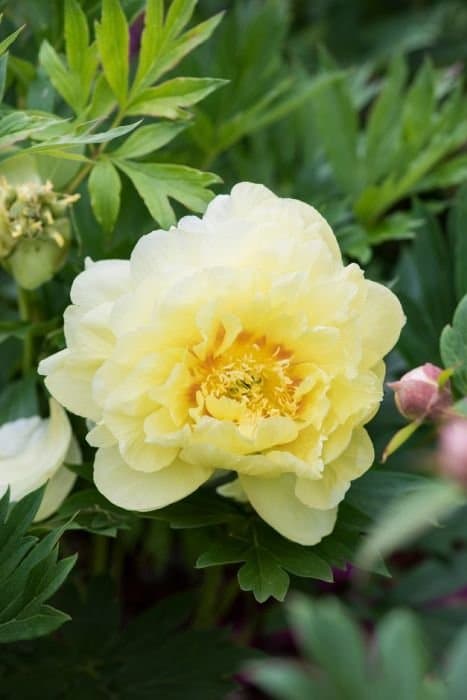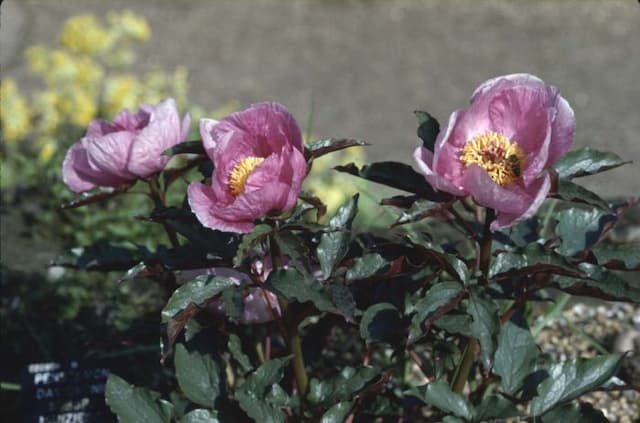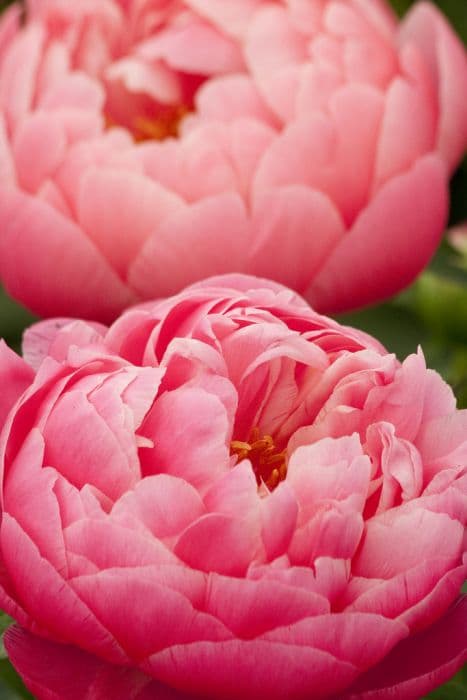Chinese Peony Paeonia lactiflora 'Jacorma'

ABOUT
The plant known as Paeonia lactiflora 'Jacorma', more commonly referred to as the Chinese peony, is a perennial that boasts an abundance of highly ornamental flowers. The blooms of this cultivar have a captivating appearance, often characterized by a rich, deep pink hue that infuses the garden with vivid color. Each flower is large and full, exhibiting numerous layers of silky petals that form an intricate, ruffled effect. These petals surround a cluster of golden yellow stamens at the center, providing a striking contrast that draws the eye. The foliage of the Chinese peony 'Jacorma' is equally attractive, with deep green leaves that have a glossy sheen. These leaves are divided into leaflets with an elegantly curved shape, offering a lush, verdant backdrop to the sensational flowers. The overall appearance is of a plant that brings a sense of drama and romance to any setting in which it is placed, captivating onlookers with its luxurious flowers and rich foliage. Blooms are typically at their best in late spring to early summer, making them a highlight of the garden during this season.
About this plant
 Names
NamesSynonyms
Chinese Peony, White Peony, Common Garden Peony.
Common names
Paeonia lactiflora 'Jacorma'.
 Toxicity
ToxicityTo humans
The common name for Paeonia lactiflora 'Jacorma' is Peony. Peonies are considered to be non-toxic to humans. As such, ingestion of peony parts typically does not lead to poisoning or severe health consequences. However, it is always wise to avoid eating ornamental plants as a precautionary measure because individual sensitivity can vary, and some people might experience mild gastrointestinal discomfort if they consume parts of the plant.
To pets
The Peony, which is the common name for Paeonia lactiflora 'Jacorma', may be toxic to pets if ingested, particularly cats and dogs. The symptoms of peony poisoning in pets can include vomiting, diarrhea, and lethargy. If a pet ingests a significant quantity of peony, it is important to contact a veterinarian as it might cause gastrointestinal upset or more serious health issues, especially if left untreated.
 Characteristics
CharacteristicsLife cycle
Perennials
Foliage type
Deciduous
Color of leaves
Green
Flower color
Pink
Height
2-3 feet (0.6-0.9 meters)
Spread
2-3 feet (0.6-0.9 meters)
Plant type
Herb
Hardiness zones
3-8
Native area
Asia
Benefits
 General Benefits
General Benefits- Aesthetic Appeal: Paeonia lactiflora 'Jacorma', also known as Peony 'Jacorma', offers beautiful, large pink flowers that can enhance the visual appeal of gardens and landscapes.
- Perennial Growth: As a perennial plant, it returns year after year, providing a long-term addition to gardens with minimal need for replanting.
- Scented Flowers: The blooms of the Peony 'Jacorma' produce a pleasant fragrance that can make outdoor spaces more inviting and enjoyable.
- Attracts Pollinators: The flowers attract bees, butterflies, and other pollinating insects, promoting biodiversity in the garden.
- Cut Flower Usage: The large, showy flowers are ideal for cutting and using in floral arrangements and bouquets, making it a popular choice for both home gardeners and professional florists.
- Symbolism and Meaning: Peonies are often associated with romance, prosperity, and good fortune, and they can be planted to embody these meanings in a garden.
- Seasonal Interest: Peonies bloom in late spring to early summer, providing seasonal interest and a burst of color after the spring bulbs have faded.
- Easy to Grow: Peony 'Jacorma' is relatively easy to care for once established, making it accessible for gardeners of different skill levels.
- Durability: Peonies are known for their hardiness and resilience, often withstanding cold winters and returning robustly in the spring.
 Medical Properties
Medical Properties- Anti-inflammatory: Peony root extract has been used in traditional medicine to reduce inflammation.
- Analgesic: It may have pain-relieving properties.
- Immunomodulatory effects: Some compounds in peony may influence the immune system.
- Antioxidant: The peony plant has been found to contain antioxidants that help in protecting cells from damage.
- Antispasmodic: Peony has been traditionally used to alleviate muscle spasms.
 Air-purifying Qualities
Air-purifying QualitiesThis plant is not specifically known for air purifying qualities.
 Other Uses
Other Uses- Culinary Garnish: Petals of Paeonia lactiflora 'Jacorma' can be used as edible garnishes on salads and desserts for a touch of elegance.
- Art & Crafts: The beautiful blooms can be pressed and used in craft projects like making homemade paper or greeting cards.
- Fragrance Extraction: Although not common, the petals can be used to extract natural fragrance for homemade perfumes or potpourri.
- Dye Production: The petals can be used to create natural dyes for fabrics or art projects.
- Cultural Festivities: In certain cultures, the blossoms may be used during festivals and weddings as part of the floral arrangements or for decorating venues.
- Floral Display: Stems of Paeonia lactiflora 'Jacorma' can be used in floral displays in places of worship or in ceremonial events for their symbolic meanings.
- Photography Props: The flowers can make excellent photography props due to their lush and vibrant blooms, adding a touch of natural beauty to still life photography.
- Teaching Material: Blossoms can be dissected and used for educational purposes to study the anatomy of flowers in biology classes.
- Garden Boundary Markers: The plant itself can be used as a pretty and natural boundary marker between different sections of a garden or property.
- Fashion Inspiration: The intricate patterns and colors of the blossoms can inspire textile designs or patterns in the fashion industry.
Interesting Facts
 Feng Shui
Feng ShuiThe Peony is often used in Feng Shui to promote love and romance, and to attract positive energy in the form of chi. It is best placed in the southwest corner of a garden or room to enhance relationship luck.
 Zodiac Sign Compitability
Zodiac Sign CompitabilityThe Peony is not used in astrology practice.
 Plant Symbolism
Plant Symbolism- Prosperity: Peonies are often associated with wealth and good fortune, making them a popular choice in floral arrangements for celebrations and business openings.
- Romance: With their lush, full blooms, peonies are symbols of romantic love and are often used in wedding bouquets and decorations.
- Beauty in All Forms: The peony represents the idea that beauty can be found in all forms, thanks to its variety of shapes, sizes, and colors.
- Compassion: Peonies can symbolize compassion and the nurturing of others, reflecting the gentle appearance of their petals.
- Honor and High Value: In some cultures, peonies embody honor and high social status because of their regal appearance.
- Femininity: The soft and rounded petals of peonies are often connected to attributes of femininity, such as grace and gentleness.
- Happy Marriage: Due to their association with romance and prosperity, peonies are also seen as an emblem of a happy and successful marriage.
 Water
WaterPeonies like the Paeonia lactiflora 'Jacorma' require consistent moisture, especially during the growing season. Water them deeply about once a week, providing about one inch of water which equals to roughly 0.623 gallons per square foot. During hot and dry periods, they may need additional water. Be careful to avoid wetting the foliage, as this can promote fungal diseases. Ensure good drainage as peonies don't like waterlogged soil; too much water can lead to root rot.
 Light
LightPeonies require full sun to flourish, so the best light condition for Paeonia lactiflora 'Jacorma' is a location where it can receive at least six hours of direct sunlight daily. They can tolerate light afternoon shade, particularly in hotter climates, but too much shade will reduce blooming. An ideal spot would be one that gets uninterrupted morning sunlight, which helps dry dew from the leaves, reducing the risk of fungal diseases.
 Temperature
TemperaturePaeonia lactiflora 'Jacorma', commonly known as peony, thrives in temperate climates. The ideal temperature range for growth is between 65°F and 75°F. They can tolerate winter temperatures down to about -20°F and summer temperatures up to 90°F. Peonies benefit from cold temperatures during dormancy as it helps with bud formation.
 Pruning
PruningPeonies such as Paeonia lactiflora 'Jacorma' should be pruned to remove spent blooms and to shape the plant in late fall after the first frost. Deadheading, or removing spent flowers, can promote more blooms and prevent the plant from putting energy into seed production. Prune back all foliage to the ground in the autumn to help prevent overwintering diseases and pests.
 Cleaning
CleaningAs needed
 Soil
SoilPeony 'Jacorma' thrives in well-draining soil enriched with organic matter such as compost. A soil pH of 6.0 to 7.0 is optimal for this peony variety to ensure nutrient availability.
 Repotting
RepottingPeonies, including 'Jacorma', rarely need repotting as they prefer to be left undisturbed and can thrive in the same location for years.
 Humidity & Misting
Humidity & MistingPeony 'Jacorma' is tolerant of typical outdoor humidity levels and does not require specific humidity conditions to flourish.
 Suitable locations
Suitable locationsIndoor
Peonies like 'Jacorma' are not ideal for indoor growth.
Outdoor
Plant in full sun, well-draining soil, water deeply, and mulch.
Hardiness zone
3-8 USDA
 Life cycle
Life cyclePaeonia lactiflora 'Jacorma', commonly known as Chinese peony, begins its life cycle as a dormant tuberous root system. In spring, the roots sprout stems and foliage, which grow until they develop into a lush bush. The foliage produces buds that bloom into large, often fragrant flowers in late spring to early summer. After flowering, the plant sets seed in the form of a capsule if pollination has occurred, with seeds typically maturing by late summer. As autumn approaches, the foliage begins to yellow and wither, with the plant entering dormancy once again through the winter months. This cycle repeats annually, with the plant potentially living for several decades if properly cared for.
 Propogation
PropogationPropogation time
Spring to Summer
Propogation: Paeonia lactiflora 'Jacorma', commonly known as Peony 'Jacorma', is most commonly propagated by division. The best time to propagate peonies by division is in the fall, after the plants have gone dormant. To propagate, a mature peony clump should be carefully lifted from the ground and the soil should be removed from the roots. The root mass is then cut into sections, making sure each division has at least 3-5 eyes, which are the potential growth points for new shoots. These divisions can be immediately replanted in a well-prepared bed, ensuring that the eyes are positioned no more than 2 inches (about 5 centimeters) deep to facilitate proper sprouting in the following spring.









